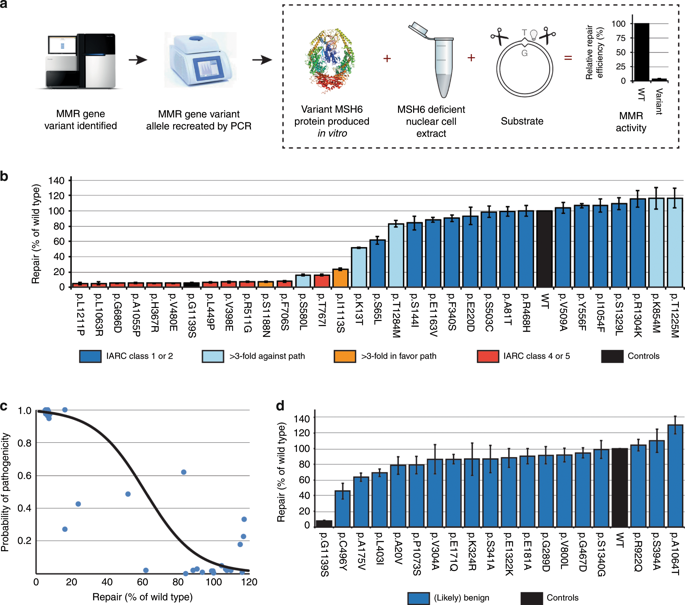当前位置:
X-MOL 学术
›
Genet. Med.
›
论文详情
Our official English website, www.x-mol.net, welcomes your feedback! (Note: you will need to create a separate account there.)
Two integrated and highly predictive functional analysis-based procedures for the classification of MSH6 variants in Lynch syndrome.
Genetics in Medicine ( IF 8.8 ) Pub Date : 2020-01-22 , DOI: 10.1038/s41436-019-0736-2 Mark Drost 1, 2 , Yvonne Tiersma 1 , Dylan Glubb 3 , Scott Kathe 4 , Sandrine van Hees 1 , Fabienne Calléja 1 , José B M Zonneveld 1 , Kenneth M Boucher 5 , Renuka P E Ramlal 1 , Bryony A Thompson 6, 7 , Lene Juel Rasmussen 8, 9 , Marc S Greenblatt 4 , Andrea Lee 4 , Amanda B Spurdle 3 , Sean V Tavtigian 6 , Niels de Wind 1
Genetics in Medicine ( IF 8.8 ) Pub Date : 2020-01-22 , DOI: 10.1038/s41436-019-0736-2 Mark Drost 1, 2 , Yvonne Tiersma 1 , Dylan Glubb 3 , Scott Kathe 4 , Sandrine van Hees 1 , Fabienne Calléja 1 , José B M Zonneveld 1 , Kenneth M Boucher 5 , Renuka P E Ramlal 1 , Bryony A Thompson 6, 7 , Lene Juel Rasmussen 8, 9 , Marc S Greenblatt 4 , Andrea Lee 4 , Amanda B Spurdle 3 , Sean V Tavtigian 6 , Niels de Wind 1
Affiliation

|
PURPOSE
Variants in the DNA mismatch repair (MMR) gene MSH6, identified in individuals suspected of Lynch syndrome, are difficult to classify owing to the low cancer penetrance of defects in that gene. This not only obfuscates personalized health care but also the development of a rapid and reliable classification procedure that does not require clinical data.
METHODS
The complete in vitro MMR activity (CIMRA) assay was calibrated against clinically classified MSH6 variants and, employing Bayes' rule, integrated with computational predictions of pathogenicity. To enable the validation of this two-component classification procedure we have employed a genetic screen to generate a large set of inactivating Msh6 variants, as proxies for pathogenic variants.
RESULTS
The genetic screen-derived variants established that the two-component classification procedure displays high sensitivities and specificities. Moreover, these inactivating variants enabled the direct reclassification of human variants of uncertain significance (VUS) as (likely) pathogenic.
CONCLUSION
The two-component classification procedure and the genetic screens provide complementary approaches to rapidly and cost-effectively classify the large majority of human MSH6 variants. The approach followed here provides a template for the classification of variants in other disease-predisposing genes, facilitating the translation of personalized genomics into personalized health care.
中文翻译:

两个基于集成和高度预测功能分析的程序,用于对 Lynch 综合征中的 MSH6 变体进行分类。
目的 DNA 错配修复 (MMR) 基因 MSH6 中的变异体在疑似 Lynch 综合征的个体中发现,由于该基因缺陷的低癌症外显率,因此难以分类。这不仅混淆了个性化医疗保健,而且还混淆了不需要临床数据的快速可靠分类程序的开发。方法 完全体外 MMR 活性 (CIMRA) 测定针对临床分类的 MSH6 变体进行校准,并采用贝叶斯规则,与致病性的计算预测相结合。为了能够验证这种双组分分类程序,我们采用了遗传筛选来生成大量失活的 Msh6 变体,作为致病性变体的代理。结果 遗传筛选衍生的变体确定了双组分分类程序显示出高敏感性和特异性。此外,这些失活变异体能够将意义不确定的人类变异体 (VUS) 直接重新分类为(可能的)致病性变异。结论双组分分类程序和遗传筛选提供了互补的方法来快速和经济有效地分类绝大多数人类 MSH6 变体。这里采用的方法为其他疾病易感基因中的变异分类提供了一个模板,有助于将个性化基因组学转化为个性化医疗保健。这些失活变体能够将意义不确定的人类变体(VUS)直接重新分类为(可能的)致病性变体。结论双组分分类程序和遗传筛选提供了互补的方法来快速和经济有效地分类绝大多数人类 MSH6 变体。这里采用的方法为其他疾病易感基因中的变异分类提供了一个模板,有助于将个性化基因组学转化为个性化医疗保健。这些失活变体能够将意义不确定的人类变体(VUS)直接重新分类为(可能的)致病性变体。结论双组分分类程序和遗传筛选提供了互补的方法来快速和经济有效地分类绝大多数人类 MSH6 变体。这里采用的方法为其他疾病易感基因中的变异分类提供了一个模板,有助于将个性化基因组学转化为个性化医疗保健。
更新日期:2020-01-22
中文翻译:

两个基于集成和高度预测功能分析的程序,用于对 Lynch 综合征中的 MSH6 变体进行分类。
目的 DNA 错配修复 (MMR) 基因 MSH6 中的变异体在疑似 Lynch 综合征的个体中发现,由于该基因缺陷的低癌症外显率,因此难以分类。这不仅混淆了个性化医疗保健,而且还混淆了不需要临床数据的快速可靠分类程序的开发。方法 完全体外 MMR 活性 (CIMRA) 测定针对临床分类的 MSH6 变体进行校准,并采用贝叶斯规则,与致病性的计算预测相结合。为了能够验证这种双组分分类程序,我们采用了遗传筛选来生成大量失活的 Msh6 变体,作为致病性变体的代理。结果 遗传筛选衍生的变体确定了双组分分类程序显示出高敏感性和特异性。此外,这些失活变异体能够将意义不确定的人类变异体 (VUS) 直接重新分类为(可能的)致病性变异。结论双组分分类程序和遗传筛选提供了互补的方法来快速和经济有效地分类绝大多数人类 MSH6 变体。这里采用的方法为其他疾病易感基因中的变异分类提供了一个模板,有助于将个性化基因组学转化为个性化医疗保健。这些失活变体能够将意义不确定的人类变体(VUS)直接重新分类为(可能的)致病性变体。结论双组分分类程序和遗传筛选提供了互补的方法来快速和经济有效地分类绝大多数人类 MSH6 变体。这里采用的方法为其他疾病易感基因中的变异分类提供了一个模板,有助于将个性化基因组学转化为个性化医疗保健。这些失活变体能够将意义不确定的人类变体(VUS)直接重新分类为(可能的)致病性变体。结论双组分分类程序和遗传筛选提供了互补的方法来快速和经济有效地分类绝大多数人类 MSH6 变体。这里采用的方法为其他疾病易感基因中的变异分类提供了一个模板,有助于将个性化基因组学转化为个性化医疗保健。


























 京公网安备 11010802027423号
京公网安备 11010802027423号